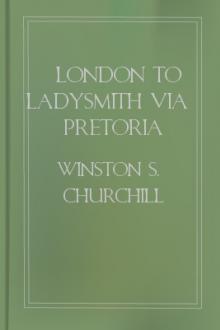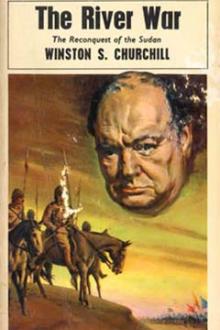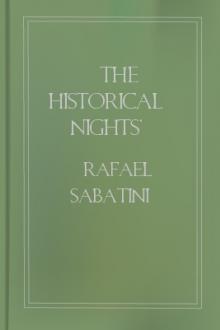London to Ladysmith via Pretoria, Winston Churchill [digital ebook reader txt] 📗

- Author: Winston Churchill
- Performer: -
Book online «London to Ladysmith via Pretoria, Winston Churchill [digital ebook reader txt] 📗». Author Winston Churchill
UPON MAJUBA DAY
Commandant's Office. Durban: March 6, 1900.
Day broke behind a cloudy sky, and the bang of an early gun reminded us that a great business was on hand. The bivouac of the Irregular Cavalry, which, since they had recrossed the river, had been set at the neck between Monte Cristo and Cingolo, was soon astir. We arose—all had slept in their boots and had no need to dress—drank some coffee and rejoiced that the day promised to be cool. It would help the infantry, and on the infantry all depended.
At half-past six Dundonald's Brigade marched towards the northern end of the Hlangwani plateau, where we were to take up positions on the spurs of Monte Cristo and along the bluffs of the south bank of the Tugela, from which we might assist the infantry attack, and particularly the attack of Barton's Brigade, by long-range rifle fire, and by our Colt battery and Maxim guns. While we marched the artillery fire grew more rapid, as battery after battery joined in the bombardment; and when we reached the high wooded ridge which we were ordered to line, I could see our shells bursting merrily in the enemy's trenches.
The position which had been assigned to the South African Light Horse afforded a close yet extensive view of the whole scene. Deep in its gorge below our feet flowed the Tugela, with the new pontoon bridge visible to the left, just below a fine waterfall. Behind us, on a rounded spur of Monte Cristo, one of the long-range batteries was firing away busily. Before us, across the river, there rose from the water's edge first a yellow strip of sandy foreshore, then steep, scrub-covered banks, and then smooth, brown slopes, terminating in the three hills which were to be successively assaulted, and which were surmounted by the dark lines of the Boer forts and trenches.
It was like a stage scene viewed from the dress circle. Moreover, we were very comfortable. There were large convenient rocks to sit behind in case of bullets, or to rest a telescope on, and the small trees which sparsely covered the ridge gave a partial shade from the sun. Opposite our front a considerable valley, thickly wooded, ran back from the river, and it was our easy and pleasant task to 'fan' this, as an American officer would say, by scattering a ceaseless shower of rifle and machine-gun bullets throughout its length. Under these satisfactory circumstances I watched the battle.
It developed very slowly, and with the deliberation which characterises all our manoeuvres. The guns gradually worked themselves into a state of excitement, and what with our musketry, supplemented by that of the Border Regiment and the Composite Battalion, whose duties were the same as ours, and the machine-guns puffing like steam engines, we soon had a capital loud noise, which I think is a most invigorating element in an attack. Besides this, the enemy's sharpshooters were curiously subdued. They found an unexpected amount of random bullets flying about, and, as they confessed afterwards, it puzzled and disturbed them.
The spectacle of two thousand men firing for half a day at nothing may provoke the comment 'shocking waste of ammunition.' Very likely there was waste. But all war is waste, and cartridges are the cheapest item in the bill. At any rate, we made it too hot for the 'snipers' to show their heads, which was certainly worth fifty men to the assaulting brigades. This method of preparing an attack by a great volume of unaimed—not undirected—rifle fire is worthy of the closest attention. I have only once before noticed its employment, and that was when Sir Bindon Blood attacked and took the Tanga Pass. Then, as now, it was most effective.
While we were thus occupied the Infantry of Barton's Brigade were marching across the pontoon bridge, turning to their right and filing along the sandy foreshore. The plan of attack to which Sir Redvers Buller had finally committed himself was as follows: Hildyard's Brigade to hold its position on the low kopjes; Barton's Brigade to cross the new pontoon bridge opposite to the left of the enemy's position, and assault the hill marked '3' on my diagram, and hereinafter called Barton's Hill. Next Kitchener's Brigade was to cross, covered by Barton's fire, to assault the centre hill marked '2,' and called Railway Hill. Lastly, Norcott's two untouched battalions were to join the rest of their brigade, and, supported by General Hart's Brigade, to attack Inniskilling Hill.
In brief, we were to stretch out our right arm, reach round the enemy's flank, and pivoting on Hildyard's Brigade crumple him from (his) left to right. It was the same plan as before, only that we now had our right hand on the Monte Cristo ridge, from which commanding position our long-range guns could enfilade and even take in reverse some of the enemy's trenches.
The leading brigade was across the river by nine o'clock, and by ten had reached its position ready for attacking at the foot of Barton's Hill. The advance began forthwith and the figures of the Infantry could be seen swarming up the steep slopes of the river gorge. The Boers did very little to stop the attack. They knew their weakness. One side of Barton's Hill was swept and commanded by the guns on Monte Cristo. The other side, at the back of which was the donga we were 'fanning,' was raked by the heavy artillery on the Hlangwani spur and by the field batteries arranged along the south side of the river. Observe the influence of the Monte Cristo ridge! It made Barton's Hill untenable by the Boers; and Barton's Hill prepared the way for an attack on Railway Hill, and Railway Hill—but I must not anticipate. Indeed, next to Monte Cristo, Barton's Hill was the key of the Boer position, and so unfortunate was the enemy's situation that he could not hold this all-important feature once he had lost the Monte Cristo ridge.
What was tactically possible and safe—for the Boer is a cautious warrior—was done. Knowing that his left would be turned he extended a sort of false left in the air beyond the end of the Monte Cristo ridge, and here he brought a gun into action, which worried us among other people but did not, of course, prevent any military movement.
By noon the whole of Barton's Hill was in the possession of his brigade, without, as it seemed to us, any serious opposition. The artillery then turned its attention to the other objectives of the attack. The Boer detached left was, however, of considerable strength, and as soon as Barton had occupied this hill (which proved, moreover, far more extensive than had been expected), he was heavily attacked by rifle fire from its under features and from a network of dongas to the eastward, and as the Artillery were busy preparing the attack on Railway Hill, the brigade, particularly the Scots and Irish Fusiliers, soon became severely engaged and suffered grievous loss.
The fact that Barton's Hill was in our possession made the Boers on Railway and Inniskilling Hills very insecure. A powerful Infantry force was holding the left of their position, and though it was itself being actively attacked on the eastern face, it could spare at least a battalion to assail their flank and threaten their rear. Covered by this flanking fire, by the long-range musketry, and by a tremendous bombardment, in which every gun, from the lumbering 5 in. siege guns to the little 9-pounder mountain battery, joined, the main attack was now launched. It proceeded simultaneously against Railway Hill, Inniskilling Hill, and the neck between them, but as the general line was placed obliquely across the Boer front, the attack fell first on Railway Hill and the neck.
The right battalions drew up in many long lines on the sides of the river gorge. Then men began gradually to work their way upwards, until all the dead patches of ground and every scrap of cover sheltered a fierce little group. Behind the railway embankment, among the rocks, in the scrub, in a cutting, near a ruined house, clusters of men eagerly awaited the decisive moment: and all this time more than seventy guns concentrated their fire on the entrenchments, scattering the stones and earth high in the air. Then, suddenly, shortly after four o'clock, all further attempts at advancing under cover were abandoned, and the Lancashire Brigade marched proudly into the open ground and on the enemy's works. The Mauser musketry burst forth at once, and the bullets, humming through the assaulting waves of infantry, reached us on our hillside and wounded a trooper in spite of the distance. But, bullets or no bullets, we could not take our eyes off the scene.
The Lancashire Brigade advanced on a wide front. Norcott's Riflemen were already prolonging their line to the right. The Boer fire was dispersed along the whole front of attack, instead of converging on one narrow column. The assault was going to succeed. We stood up on our rocks. Bayonets began to glitter on the distant slope. The moving lines increased their pace. The heads of the Boers bobbing up and down in their trenches grew fewer and fewer. They knew the tide was running too strongly. Death and flight were thinning their ranks. Then the sky-line of Railway Hill bristled with men, who dropped on their knees forthwith and fired in particular haste at something that was running away down the other side. There was the sound of cheering. Railway Hill was ours. I looked to the left.
The neck between the hills was lined with trenches. The South Lancashire Regiment had halted, pinned to the ground by the Boer fire. Were they going to lose the day for us when it was already won? The question was soon answered. In an instant there appeared on the left of the Boer trench a dozen—only a dozen—violent forms rushing forward. A small party had worked their way to the flank, and were at close quarters with cold steel. And then—by contrast to their former courage—the valiant burghers fled in all directions, and others held out their rifles and bandoliers and begged for mercy, which was sometimes generously given, so that by the time the whole attack had charged forward into the trenches there was a nice string of thirty-two prisoners winding down the hill: at which token of certain victory we shouted loudly.
Inniskilling Hill alone remained, and that was almost in our hands. Its slopes were on three sides alive with the active figures of the Light Brigade, and the bayonets sparkled. The hill ran into a peak. Many of the trenches were already deserted, but the stone breastwork at the summit still contained defenders. There, painted against the evening sky, were the slouch hats and moving rifles. Shell after shell exploded among them: overhead, in their faces, in the trench itself, behind them, before them, around them. Sometimes five and six shells were bursting on the very apex at the same instant. Showers of rock and splinters fell on all sides.
Yet they held their ground and stayed in greater peril than was ever mortal man before. But the infantry were drawing very near. At last the Dutchmen fled. One, a huge fellow in a brown jersey, tarried to spring on the parapet and empty his magazine once more into the approaching ranks, and while he did so a 50 lb. lyddite shell burst, as it seemed, in the midst of him, and the last defender of Inniskilling Hill vanished.
Then the artillery put up their sights and began to throw their shells





Comments (0)